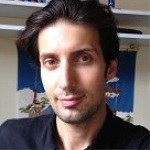Prof. Denis Burdakov views the brain as a series of logic gates that can be described in mathematical models. He tests these ideas at the Department of Health Sciences and Technology, ETH Zurich, where he just started at the Institute for Neuroscience. We talked with him about his research plans.
What is your research interest?
I investigate brain states, circuits, and algorithms underlying complex adaptive behavior. In lay terms, “neural rules for intelligence”. It’s interesting to see how evolution has designed the brain to enable us to survive our complex and changeable world. I am interested in how these abilities arise from the inner workings of the brain, especially from rapid neural computations.
adaptive behavior. In lay terms, “neural rules for intelligence”. It’s interesting to see how evolution has designed the brain to enable us to survive our complex and changeable world. I am interested in how these abilities arise from the inner workings of the brain, especially from rapid neural computations.
What is your “best research moment” so far?
Realizing that complicated biological behavior can emerge from simple logical rules. That sometimes all the “pieces to the puzzle” are already known, and just need a bit of mathematics to make sense. An example from my work is about calculating calcium dynamics inside the cell. It was assumed in the field that yet-unknown genetic and molecular mechanisms were needed to account for certain features of these dynamics. However, by modeling basic interactions between already-known calcium transport proteins and using basic laws of physics, we were able to show that the complex dynamics arises from the known simple building-blocks.
What are the implications of your research results?
My research makes causal links between specific, genetically-defined brain signals, and a particular behavior or brain state. For example, recently we defined signals underlying voluntary running and risk-avoidance behaviors. Understanding which brain signals cause which behaviors helps us target these brain signals in disease states. If we then also understand the underlying general algorithms, we can use them to build brain-like “bio-inspired” machines that can help humans (e.g. machines that assist brain function after a stroke).
Another part of my research looks at different ways of controlling known brain signals. For example, signals emitted by brain orexin neurons are known to make us thinner and more awake; without orexin neurons humans develop the disorder narcolepsy. A few years ago, we showed that these orexin cell signals can be regulated by certain nutrients in the diet, suggesting that these important brain signals can be tuned by specific diets. With these types of projects, we can bring basic research closer to lay people, and at the same time the results can have direct benefits for the general public. I find it comforting to have both basic and applied implications in my research.
What are you looking forward to, working in Zurich?
I look forward to truly multidisciplinary interactions, especially with engineering groups that are excellent in Zurich. For measuring our experimental systems, we rely on sophisticated robots and we work with engineering teams to develop these robotic systems for mutually-interesting experiments. The good thing is that at D-HEST engineers are working in the same department as medical researchers and biologists. This unique cluster of disciplines is highly attractive and, honestly, dearly needed to move neuroscience research forward.
What can you tell us about your research plans?
In my group, which now consists of 5 scientists and 2 administrators – 3 more scientists will soon join, we plan to first causally identify brain signals necessary for intelligent behavior, and then figure out what algorithms best describe them. The orexin system and other brain government systems, i.e. systems that operate brain-wide, will continue to be our focus due to their relevance for a wide range of brain functions and brain disorders. For this research, we combine tools of modern neurophysiology (optogenetic actuators and reporters, electrophysiology), behavioral analysis (video-tracking, touch sensors), genetics (cell-type-specific targeting of reporter and actuator proteins, genetically-targeted neurocircuit tracing), and computational modelling (predicting neural or behavioral dynamics from circuit architectures).
Denis Burdakov was appointed in 2016 at the ETH, his lab has moved to locations in Zurich in September 2018.
For more information see Burdakov lab website